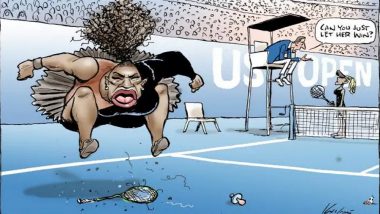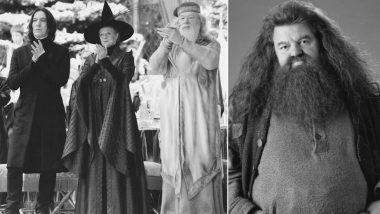The controversy surrounding Serena Williams’ loss in the U.S. Opens finals to Naomi Osaka refuses to die down. Rupert Murdoch’s Herald Sun in Australia is facing a global backlash for a cartoon depicting Serena Williams in a manner which is racist and sexist.
William's loss to Naomi Osaka was marred by on court arguments between her and the chair umpire. Williams smashed her racquet and called the umpire a "thief" and a "liar" as she was given three code violations by Carlos Ramos – the first for receiving coaching, the second for racquet abuse and the third for verbal abuse of the umpire. The second and third violations earned Williams a point penalty and then a game penalty, giving Osaka a 5-3 second-set lead that Williams could not overcome.
The cartoon by Mark Knight, depicted the tennis star's riff with the umpire that caricatured her. Williams was depicted with a mannish physique, fat lips and physical features that herald back to racist depictions of African American women along with having a tantrum on the court at the U.S. Open. The depiction of Osaka has also been criticised as making her appear as a “white woman”.
“It had nothing to do with gender or race.”
Herald Sun backs Mark Knight’s cartoon on Serena Williams: https://t.co/i1NBGO8xJw pic.twitter.com/BTFONVWHh8
— Herald Sun (@theheraldsun) September 10, 2018
Condemnation of the cartoon has come from American civil rights activists, British author JK Rowling and numerous sports journalists and activists.
Well done on reducing one of the greatest sportswomen alive to racist and sexist tropes and turning a second great sportswoman into a faceless prop. https://t.co/YOxVMuTXEC
— J.K. Rowling (@jk_rowling) September 10, 2018
The National Association of Black Journalists said the cartoon was “repugnant” on many levels. “The Sept 10 cartoon not only exudes racist, sexist caricatures of both women, but Williams’ depiction is unnecessarily sambo-like,” the association said.
“The art of editorial cartooning is a visual dialogue on the issues of the day, yet this cartoon grossly inaccurately depicts two women of colour at the U.S. Open, one of the grandest stages of professional sports.”
One of U.S.’s biggest newspapers, the Washington Post also castigated the imagery drawn by Knight.
The Washington Post linked Knight’s drawing to the manner in which facial features of African Americans were reflected as caricatures during times of slavery in the 19th and 20th centuries.
“Knight’s cartoon conjures up a range of such caricatures that were branded on memorabilia and popularized on stage and screen of the era, including the minstrel-show character Topsy born out of ‘Uncle Tom’s Cabin’, as well as the title character in 1899’s ‘Little Black Sambo’,” the article said.
Other U.S. media pointed out that the juxtaposition of Osaka portrayed as petite and feminine with jet blonde straight hair was also incorrect – in real life she has dark curly hair with blonde streaks and is taller than Williams.
Then there is the issue of gender. The top three tennis players in the world—Rafael Nadal, Roger Federer, and Novak Djokovic—have all smashed their tennis racquets in fits of anger. In 2009, Roger Federer, considered to be the greatest men’s tennis player who ever existed, told an umpire: “I don’t give a shit what he [the line judge] says. Don’t fucking tell me the rules.” But we are yet to see a cartoon of the angry Swiss.
An analysis on BBC’s website notes that the "angry black woman" trope has its roots in 19th Century America, when minstrel shows, which involved comic skits and variety acts, mocking African Americans became popular.
Blair Kelley, associate professor of history at North Carolina State University, says black women were often played by overweight white men who painted their faces black and donned fat suits "to make them look less than human, unfeminine, ugly".
"Their main way of interacting with the men around them was to scream and fight and come off angry, irrationally so, in response to the circumstances around them," she says.
The article says the picture of the "hyperemotional" black woman has become more commonplace as Americans grapple with issues of polarised politics and civility. Law professor Trina Jones says that "Black women are not supposed to push back and when they do, they're deemed to be domineering. Aggressive. Threatening. Loud." Knight’s cartoon obviously draws heavily from this imagery.
In a 2016 interview with Oprah Winfrey, former First Lady Michelle Obama echoed the same sentiment. "You think, that is so not me! But then you sort of think, well, this isn't about me," she said of being labelled as an "angry black woman".
"This is about the person or the people who write it...We are so afraid of each other, you know?"
(The above story first appeared on LatestLY on Sep 12, 2018 03:54 AM IST. For more news and updates on politics, world, sports, entertainment and lifestyle, log on to our website latestly.com).













 Quickly
Quickly




















